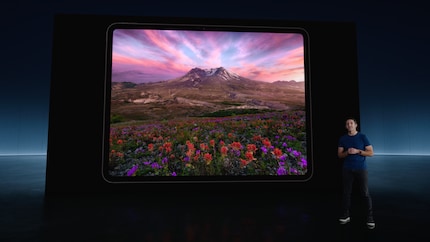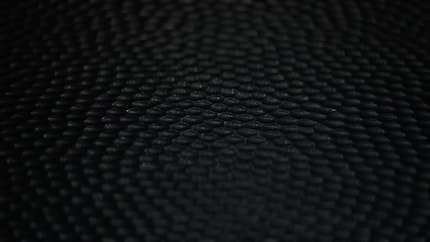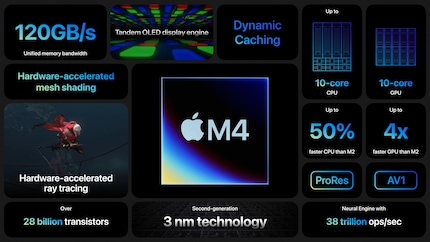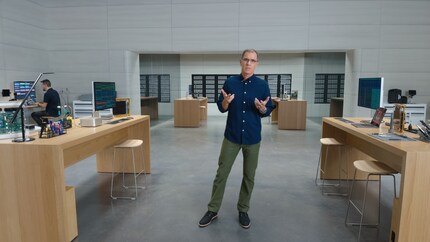
News + Trends
New iPads unveiled: iPad Pro gets OLED display, but no calculator app
by Michelle Brändle

Apple’s new iPad Pro features an outstanding display and a surprisingly early chip update. Sooner or later, they’ll find their way into laptops, desktops and monitors.
Apple usually introduces new displays and chips in MacBooks. But this time it’s the iPad Pro that’s first to receive two major technological advances. Apple has conjured the M4 out of the lab surprisingly early – just six months after launching the M3. The real sensation, however, is the new tandem OLED display.
The new iPad Pro is the first iPad with an OLED display. This has long been expected. But here’s what nobody saw coming – Apple didn’t just install a normal panel. According to iPad boss John Ternus, this wouldn’t offer the brightness and colour reproduction that customers expect. Instead, the California-based company combines two panels to form a tandem OLED. If you believe the specifications, the result is truly impressive:
1,000 nits full-screen brightness, 1,600 nits peak brightness.
The peak brightness is good, but a side note. Ordinary OLEDs manage that too. But a thousand nits full screen?! Until now, only LCDs with LED backlighting have achieved such values in this display size. In contrast, however, an OLED display offers perfect black levels and avoids any blooming.

To put this into perspective, the brightest OLED laptops achieve a maximum of 600 nits full screen. OLED TVs and monitors manage just 250 nits, i.e. a quarter. Smartphones already achieve over 1000 nits. But size is crucial. The more surface area the LEDs have to cover, the more energy they need for the same brightness. This produces more heat – the enemy of all OLEDs. Small displays with a high pixel density have an advantage, as diodes that are close together appear brighter. A 13-inch OLED with 1,000 nits is a real achievement.
The iPad Pro achieves this groundbreaking brightness with both SDR and HDR content. The peak value only applies to HDR. Tandem OLED apparently offers XDR colour precision. I’ve no idea what that’s about, but since Apple’s panels generally display colours very well, you can expect high colour space coverage and accuracy.
Tandem OLED also supports ProMotion, i.e. an adaptive picture frequency of up to 120 hertz. However, the lowest frequency is now 10 Hertz, no longer 24 Hertz. This reduces the energy required for static content, which tends to be higher for OLED than for LCD with LED backlighting.

The resolution of the displays is 2420 × 1668 pixels for the 11-inch model and 2752 × 2064 pixels for the 13-incher. This results in a pixel density of 264 pixels per inch (ppi) – slightly higher than the 254 ppi of the MacBook Pro. Apple can optionally provide the screen with an anti-reflective coating. It’s probably the same as the Studio Display or the Pro Display XDR.

Will the iPad Pro be susceptible to burn-in? Probably not. The risk of ghosting increases the warmer a panel becomes. According to the display manufacturer, however, two panel levels reduce the heat. This is because the pixels of the individual panels have to shine with less intensity on average and therefore run in a more efficient range. It remains to be seen whether this will still be true if the brightness is increased to a total of 1000 nits.
It’ll also be exciting to see when the technology finds its way into laptops and monitors. Apple calls the display Ultra Retina XDR. The name reads like a successor to the Liquid Retina XDR, which is installed in the old iPad Pro and the current MacBook Pro. However, current rumours don’t expect OLED MacBooks until 2026.
Last October, Apple presented the M3, its first 3-nanometre chip. The fact that the M4 arrives just six months later is a surprise. On closer inspection, however, the early update makes sense.
On the one hand, the M4 appears to differ only slightly from its predecessor. It has two additional efficiency cores, but also four performance cores – in a slimmed-down version, found in the cheaper iPad Pro, there are only three. The 10-core GPU will probably remain the same as before. Just like Neural Engine, responsible for accelerating artificial intelligence (AI). It has 16 cores in the M4, just like in the M3. A new addition is the display engine for the tandem OLED display.

On the other hand, the leap in generation is probably primarily about production. Apple has its chips produced by TSMC. The M3 is based on the N3B manufacturing process, it’s relatively inefficient. Many wafers have defects and have to be fixed – which makes production expensive. The new M4, in contrast, presumably stems from the new N3E production line, way more efficient. This allows TSMC to produce more chips that are more readily available and either faster or cheaper.

What does the early debut of the M4 mean for Macs? The Mac Mini and Mac Studio will probably skip the M3 generation. They’ll probably receive the M4 and a highly powerful M4 Ultra directly. This’ll probably come in a month’s time, when Apple presents its entry into artificial intelligence at WWDC. The MacBook Pro is expected to switch to M4 in the fall. iMac and MacBook Air probably won’t benefit from the latest chips until next year.
Of course, I’ll be testing the M4 and the new display in the iPad Pro – if I can ever snatch it away from fellow editor Michelle Brändle.
You can pre-order the new iPads from us now:
My fingerprint often changes so drastically that my MacBook doesn't recognise it anymore. The reason? If I'm not clinging to a monitor or camera, I'm probably clinging to a rockface by the tips of my fingers.
Interesting facts about products, behind-the-scenes looks at manufacturers and deep-dives on interesting people.
Show all